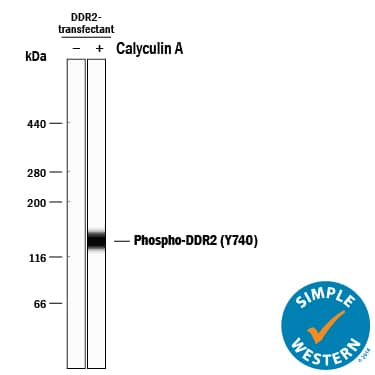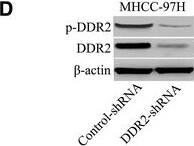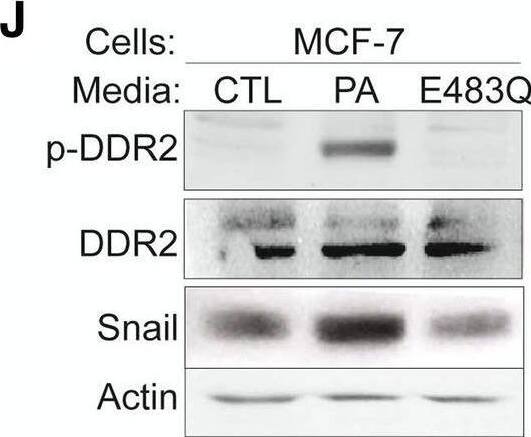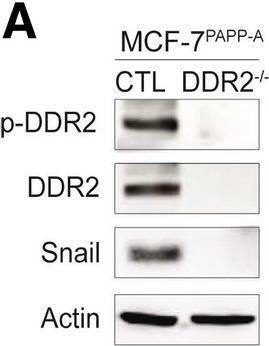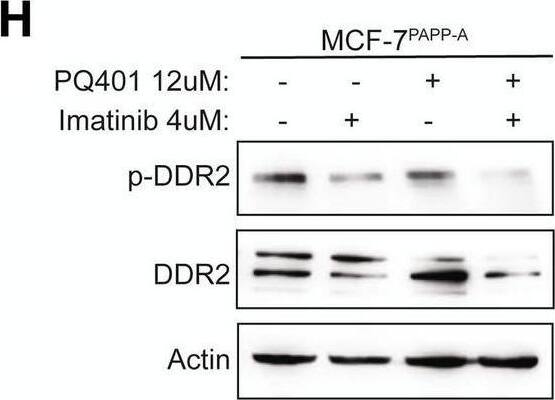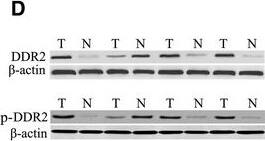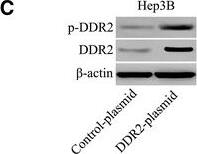Human Phospho-DDR1/DDR2 (DDR1 Y796, DDR2 Y740) Antibody
R&D Systems, part of Bio-Techne | Catalog # MAB25382
Recombinant Monoclonal Antibody.

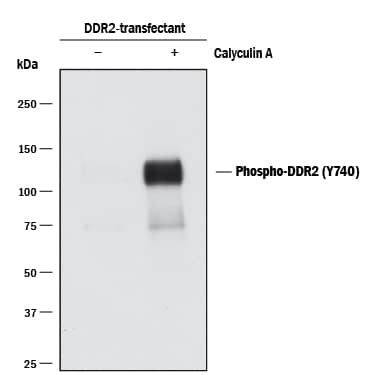
Conjugate
Catalog #
Key Product Details
Validated by
Biological Validation
Species Reactivity
Validated:
Human
Cited:
Human, Mouse, Primate - Cercopithecus aethiops (African Green Monkey)
Applications
Validated:
Western Blot, Simple Western
Cited:
Immunohistochemistry, Western Blot, Immunocytochemistry
Label
Unconjugated
Antibody Source
Recombinant Monoclonal Rabbit IgG Clone # 1119D
Product Specifications
Immunogen
Phosphopeptide containing the human DDR2 Y740 site
Accession # Q16832
Accession # Q16832
Specificity
Detects human DDR1 and DDR2 when phosphorylated at Y796 and Y740.
Clonality
Monoclonal
Host
Rabbit
Isotype
IgG
Scientific Data Images for Human Phospho-DDR1/DDR2 (DDR1 Y796, DDR2 Y740) Antibody
Detection of Human Phospho-DDR2 (Y740) by Western Blot.
Western blot shows lysates of HEK293 human embryonic kidney cell line transfected with human DDR2 untreated (-) or treated (+) with 100 nM Calyculin A (Catalog # 1336) for 10 minutes. PVDF membrane was probed with 0.1 µg/mL of Rabbit Anti-Human Phospho-DDR1/DDR2 (DDR1 Y796, DDR2 Y740) Monoclonal Antibody (Catalog # MAB25382) followed by HRP-conjugated Anti-Rabbit IgG Secondary Antibody (Catalog # HAF008). A specific band was detected for Phospho-DDR2 (Y740) at approximately 120-130 kDa (as indicated). This experiment was conducted under reducing conditions and using Immunoblot Buffer Group 1.Detection of Human Phospho-DDR2 (Y740) by Simple WesternTM.
Simple Western lane view shows lysates of HEK293 human embryonic kidney cell line transfected with human DDR2 untreated (-) or treated (+) with 100 nM Calyculin A (Catalog # 1336) for 10 minutes, loaded at 0.2 mg/mL. A specific band was detected for Phospho-DDR2 (Y740) at approximately 130 kDa (as indicated) using 1 µg/mL of Rabbit Anti-Human Phospho-DDR1/DDR2 (DDR1 Y796, DDR2 Y740) Monoclonal Antibody (Catalog # MAB25382). This experiment was conducted under reducing conditions and using the 66-440 kDa separation system.Detection of Phospho-DDR1/DDR2 (DDR1 Y796, DDR2 Y740) by Western Blot
Prognostic value of DDR2 protein expression in HCC and its correlation with phosphorylated DDR2 (p-DDR2) in HCC cells. a Overall survival for DDR2 protein expression (log-rank, P < 0.01). b Disease-free survival for DDR2 protein expression (log-rank, P < 0.01). c Immunoblotting analysis of DDR2 and p-DDR2 in Hep3B cells with DDR2 expressing plasmid transfection or control plasmid transfection. d Immunoblotting analysis of DDR2 and p-DDR2 in MHCC-97H cells with DDR2-shRNA transfection or control-shRNA transfection Image collected and cropped by CiteAb from the following open publication (https://pubmed.ncbi.nlm.nih.gov/26362312), licensed under a CC-BY license. Not internally tested by R&D Systems.Applications for Human Phospho-DDR1/DDR2 (DDR1 Y796, DDR2 Y740) Antibody
Application
Recommended Usage
Simple Western
1 µg/mL
Sample: HEK293 human embryonic kidney cell line transfected with human DDR2 treated with Calyculin A
Sample: HEK293 human embryonic kidney cell line transfected with human DDR2 treated with Calyculin A
Western Blot
0.1 µg/mL
Sample: HEK293 human embryonic kidney cell line transfected with human DDR2 treated with Calyculin A
Sample: HEK293 human embryonic kidney cell line transfected with human DDR2 treated with Calyculin A
Formulation, Preparation, and Storage
Purification
Protein A or G purified from cell culture supernatant
Reconstitution
Reconstitute at 0.5 mg/mL in sterile PBS. For liquid material, refer to CoA for concentration.
Formulation
Lyophilized from a 0.2 μm filtered solution in PBS with Trehalose. *Small pack size (SP) is supplied either lyophilized or as a 0.2 µm filtered solution in PBS.
Shipping
Lyophilized product is shipped at ambient temperature. Liquid small pack size (-SP) is shipped with polar packs. Upon receipt, store immediately at the temperature recommended below.
Stability & Storage
Use a manual defrost freezer and avoid repeated freeze-thaw cycles.
- 12 months from date of receipt, -20 to -70 °C as supplied.
- 1 month, 2 to 8 °C under sterile conditions after reconstitution.
- 6 months, -20 to -70 °C under sterile conditions after reconstitution.
Background: DDR1/DDR2
References
- Vogel, W.F. et al. (2006) Cell. Signal. 18:1108.
- Karn, T. et al. (1993) Oncogene 8:3433.
- Vogel, W. et al. (1997) Mol. Cell 1:13.
- Leitinger, B. (2003) J. Biol. Chem. 278:16761.
- Leitinger, B. and A.P.L Kwan (2006) Matrix Biol. 25:355.
- Leitinger, B. et al. (2004) J. Mol. Biol. 344:993.
- Mihai, C. et al. (2006) J. Mol. Biol. 361:864.
- Olaso, E. et al. (2001) J. Clin. Invest. 108:1369.
- Ikeda, K. et al. (2002) J. Biol. Chem. 277:19206.
- Xu, L. et al. (2005) J. Biol. Chem. 280:548.
- Wang, J. et al. (2002) J. Autoimmun. 19:161.
- Ferri, N. et al. (2004) Am. J. Pathol. 164:1575.
Long Name
Discoidin Domain Receptor 1/Discoidin Domain Receptor 2
Alternate Names
6030432F18;AI323681;CAK;CD167;CD167a;DDR;DDR1;Drd1;EDDR1;HGK2;MCK10;Mpk6;NEP;NTRK4;PTK3;PTK3A;PTK3D;RTK6;TRKE
UniProt
Additional DDR1/DDR2 Products
Product Documents for Human Phospho-DDR1/DDR2 (DDR1 Y796, DDR2 Y740) Antibody
Product Specific Notices for Human Phospho-DDR1/DDR2 (DDR1 Y796, DDR2 Y740) Antibody
For research use only
